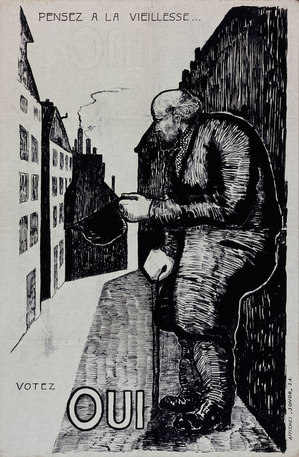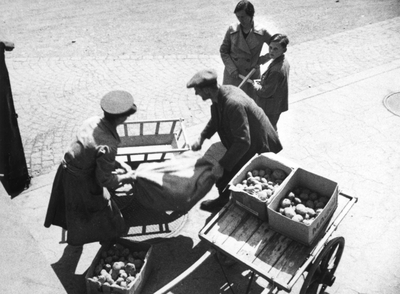
Unternavigation
The Poor
Throughout the history of the social welfare state, quite different groups of people have been called poor; it depended on how poverty was socially perceived. In every epoch, though, poverty has been addressed as a moral issue. Modern societies often distinguish between two categories: the ill-fated, involuntarily poor, and the complicit poor, partly or fully to blame for their plight.
In the Middle Ages, as in antiquity, the poor were frequently socially ostracized. Yet with Christianization, a more positive image began to spread that was based on apostolic poverty. Following the example of Christ, mendicant orders (friars, religious sisters) voluntarily pursued a life of poverty. The poor also served a social function. As the recipients of alms, they were in turn expected to pray for the salvation of those whose gifts they accepted. Those with neither physical strength nor social influence were considered "poor", and they included the elderly, the sick, invalids, widows, strangers, pilgrims, and beggars. Between the 10th and 14th centuries, the ranks of the poor swelled due to crop failures, famines, feuds among noblemen, and epidemics. Demographic changes also played a role. Increasingly, poverty also began to befall wage laborers, day laborers, and servants; women constituted the majority of the poor.
For many years, denominational charities cared for the poor. During the 14th and 15th centuries, poverty came to be dealt with differently, and came increasingly under secular control, a development which continued during the Reformation. Secular authorities believed that only the "worthy" poor should benefit from financial support, in contrast to the "unworthy" poor who were assumed to have been themselves responsible for their situation. The "unworthy poor" included those who were voluntarily poor, such as the Beguines, and the able-bodied impoverished, as well as strangers and travellers. In a moralizing manner, they were accused of voluntarily indulging in idleness, thereby depriving the genuinely poor of their alms. Using repressive measures, including bans on begging, compulsory labor, or expulsion from a territory, acts by the authorities were directed particularly against beggars, travellers, and foreigners.
The population in Switzerland grew in the 16th century, but famine and inflation also increased due to periodic crop failures. At least temporarily, 60 to 80 percent of the population lived in poverty. Peddlers, minstrels, itinerant craftsmen, and even mercenaries often lived at a bare subsistence level and were constantly in danger of slipping into poverty. Municipal authorities set limits, specifying the groups they deemed worthy of poor relief, and access to aid was reserved to those who held rights in the city or territory. Acquiring such rights, or the permission to marry, depended upon having a certain level of wealth or the possession of specific assets; in this sense, the impoverished had their rights curtailed.
In the first half of the 19th century, up to one-fifth of the Swiss population was impoverished, particularly those in agriculture-dependent sectors. To some degree, industrialization, population growth, and local or regional subsistence crises (Hungerkrisen) did exacerbate poverty. Into the 19th century, the "unworthy" poor – a category which included beggars, the itinerant and the homeless – continued to be stigmatized and persecuted. But after 1850, the situation improved. Due to new opportunities for gainful employment in building railroads or doing factory work, unemployment decreased. However, the poverty-stricken lower classes often included wage laborers.
Poverty began to be perceived differently starting in the 1840s. It was increasingly seen as a problem connected to the industrial age and a part of the "social question". The focus shifted to the precarious living conditions of the industrial workforce, a group perceived as a new social stratum. Using social policy measures, politicians tried to mitigate the poverty risks illness, accidents, and unemployment represented. The locally resident poor were the primary beneficiaries of these new features. Over time, their rights would come to be put on an equal footing with those of citizens. Marginalized groups such as the homeless or itinerants remained subject to an increased risk of impoverishment, and women remained overrepresented among the destitute population. The stigmatization of poverty remained high; many poor people turned to welfare institutions for support late or not at all as a result. Contemporaries spoke of the "shamefaced poor".
Economic growth up until the First World War further reduced the number of the poor. However, a more hidden poverty blossomed at the same time, with home-based workers and those engaged in agriculture often living barely above the subsistence level. Such groups often remained unmentioned in the great debates about the "social question".
The First World War hit a Switzerland what was largely unprepared for it, and triggered persistent inflation and supply shortages. Many companies halted production in the early war years, leading to pay cuts, and along with rising food costs, these particularly affected the wage-dependent population, both blue- and white-collar. Although net wages did increase again by the end of the war, due to inflation real wages fell by 25-30 percent at a time when the cost of living rose by 130-150 percent. The winners in this crisis were middlemen and speculators, along with the industrial owners of capital, but farmers also did well. There were widespread food shortages by the end of the conflict, and for the first time in the nation’s history, broad segments of the population experienced hunger and malnutrition. By 1918, from one-sixth to one-quarter of the population was receiving government assistance, and increasing social inequality erupted in numerous workers’ strikes, including a national strike that year. Socio-political measures taken afterwards only temporarily eased the situation; there were major national economic crises in 1921 and 1922 and from 1932 to 1939. These led to a decline in various sectors, particularly affecting the textile, watchmaking and metal industries. Unemployment rose sharply until the mid-1930s, and it would not be until the Second World War and in the years following it that the economy recovered.
The living standards among broad segments of the population improved as a result of the boom years during the 1950s and 1960s. The working class did also benefit from increasing overall prosperity, but lower and middle-income wages rose only slowly relative to economic growth rates. While poor people largely disappeared from public view, they were replaced by new groups experiencing poverty; the trend toward hidden poverty continued. Those affected by this new poverty were often referred to as marginalized groups, and they included some segments of the population living in the mountain areas, foreigners, and the marginalized in the cities, such as addicts. Old age and illness remained major poverty risks, and during the 1950s and 1960s, the social security payments (AHV) were not enough to provide a living wage. Disability insurance (IV) also would not be introduced until 1960. Unmarried, divorced, or widowed women were also disproportionately disadvantaged, and even employed women often worked in low-paying occupations in which women were in the majority. The low income they earned in turn affected how much they could contribute into the social security system, and this ultimately, if indirectly, had an affect on the pensions they would later receive.
To this day, poverty primarily affects socially and economically worse-off groups of people. They include single mothers, families with many children, pensioners, and the long-term unemployed. The persistently high cost of living in the country also contributes to newer forms of poverty. Since the 1990s, the term "working poor" has established itself as a means to describe those who remain poor despite being employed. At the end of the 1990s, the number "working poor" in Switzerland stood at about 250,000. It was largely made up of those with low skill levels, single-parent households, and families with foreign citizenship and more than three children. According to surveys by the Swiss Federal Statistical Office, between 2007 and 2012, from 14.2 to 15.6 percent of the population were considered at poverty risk. In 2012, 590,000 people, and around 702,000 people in 2022; 144,000 of them despite being in gainful employment. Self-employment and fixed-term employment contracts are considered a poverty risk in this respect.
Poverty can be measured in different ways and have different effects on living conditions. Since 2021, a new indicator has been introduced in Switzerland, namely "material and social deprivation", which measures how many people have to forego services, social activities or important goods due to financial reasons.
Literatur / Bibliographie / Bibliografia / References: Bundesamt für Statistik BFS (2014), Armut in der Schweiz 2007 bis 2012, Neuchâtel. Online: https://www.bfs.admin.ch/bfsstatic/dam/assets/349392/master, Stand: 11.03.2021; Crettaz Eric (2018), Working Poor in der Schweiz: Ausmass und Mechanismen, Social Change in Switzerland, https://www.socialchangeswitzerland.ch/?p=1514, Stand: 29.01.2021; Epple Ruedi, Schär Eva (2010), Stifter, Städte, Staaten. Zur Geschichte der Armut, Selbsthilfe und Unterstützung in der Schweiz 1200-1900, Zürich; HLS: Armut, Erster Weltkrieg, Weltwirtschaftskrise; O. A. (1864), Verschämte Arme, in: Pierer’s Universal-Lexikon, Band 18, 511-512. Online: http://www.zeno.org/Pierer-1857/A/Versch%C3%A4mte+Arme, Stand: 29.01.2021.
(09/2024)





